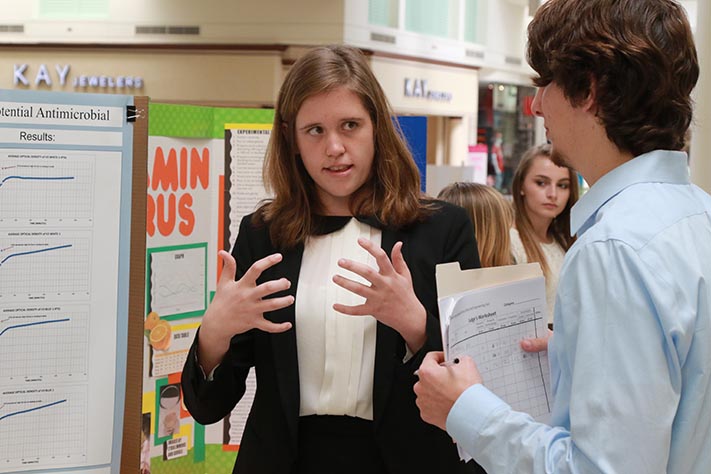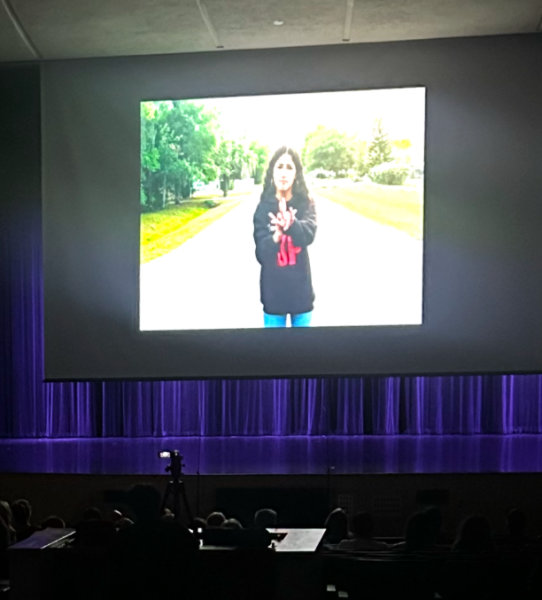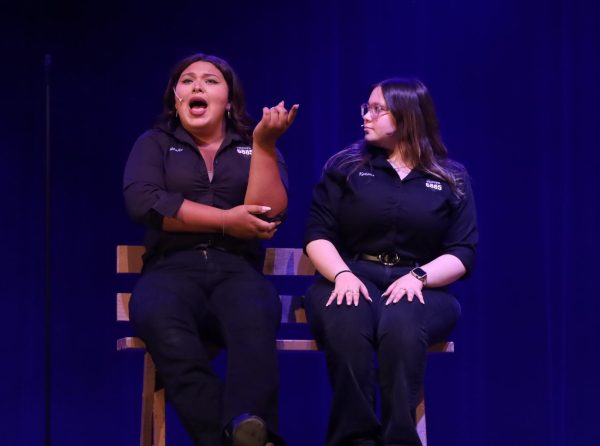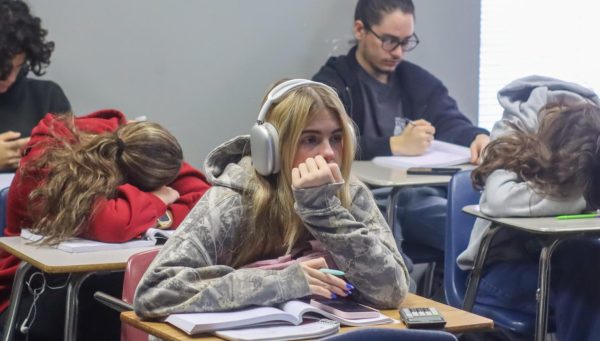Rising past benchmarks
photo by Jacob Arthur
Junior Tess Marvin explains her project to a judge at the 2016 SCPS Regional Science, Math and Engineering Fair on Feb. 13. Marvin’s Molecular and Cellular Biology project was judged by a variety of experts in different fields.
Crouching over a lab table, junior Tess Marvin conducts her experiment targeting “bad” bacteria. Marvin traveled to Phoenix May 8 – 13 to share her project at the Intel International Science and Engineering Fair.
Marvin began her project in the experimental science class, where she decided to focus on inhibiting bacterial growth through targeting the areas of bacteria cells that produce protein. To do this, Marvin decided to analyze what keeps bacteria alive and growing: small ribonucleic acid. The sRNA found in all bacteria is what contributes to their survival because it regulates protein production. Marvin’s project aimed to use sRNA to negatively affect cellular growth.
The trouble with Marvin’s focus on stopping ribosomal growth was that she could not use it to target all types of ribosomes, as humans have ribosomes they need. Instead, they needed to focus on specific bacterial ribosomes, meaning that Marvin had to isolate the specific bacteria she wanted to target.
“Her research had such great application, that you knew she would go far,” experimental science student, senior Lauren Neldner said. “I’m amazed she came up with this and was able to execute it so well.”
After conducting over 50 hours of experimentation to support her research and hypothesis, Marvin formulated all her data and observations into a research report, poster and abstract before she was able to bring her project to the 2016 SCPS Regional Science, Math and Engineering Fair on Feb. 13. There, she took second place in Cellular and Molecular Biology and, to her shock, was able to proceed to states. This came as a surprise because only a small portion of second place winners are able to move on.
Before proceeding to the 61st State Science and Engineering Fair, Marvin had to double-check all her statistics, as well as refresh her knowledge in preparation of her mini-presentation. One major difference between regionals and states was her focus. At regionals, Marvin focused on the science behind her project, but at states, she spoke about her journey through her project, including how she first came up with the idea and how she overcame the different obstacles she encountered. At state, Marvin won first place in Cellular and Molecular Biology and one of eight Best in Fair titles.
“She had a lot of hurdles and issues, but for her, science fair isn’t about winning. It’s about what you learn along the way and if you proved what you wanted and how well you performed,” Neldner said. “She truly is in it for the sake of science and learning.”
As a result of her Best in Fair, Marvin was invited to compete at ISEF, where she received an Award of Outstanding Achievement for Ability and Creativity in Science and Engineering Project as well as an accolade from the China Association for Science and Technology, which came with a $1,200 award.
A highlight of Marvin’s ISEF experience was that she was able to attend several symposium, which were lectures “hosted by experts in their field [that provided] insight in everything from patent laws to statistical practices,” Marvin said.
Another bonus for Marvin was the chance to meet Nobel laureates, authors of science publications and finalists from all over the world, including countries such as Australia, Azerbaijan, Singapore, Nigeria and more.
“Their perspectives of science and culture were intriguing and exciting,” Marvin said. “It was truly an amazing opportunity to be able to explain my project to students … and hear about their respective projects as well.”
Marvin was also able to explain her project to local elementary school children on field trips. It was significant because it allowed her to teach something to them that they had never been exposed to before.
“Watching kids become excited about something I’m so passionate about – science – was worth all the work it took to make it to ISEF,” Marvin said.
Your donation will support the student journalists of Hagerty High School. Your contribution helps us publish six issues of the BluePrint and cover our annual website hosting costs. Thank you so much!














Robin | Jun 1, 2016 at 4:21 am
Other than awards, what were the results of the project? Nice job Tess